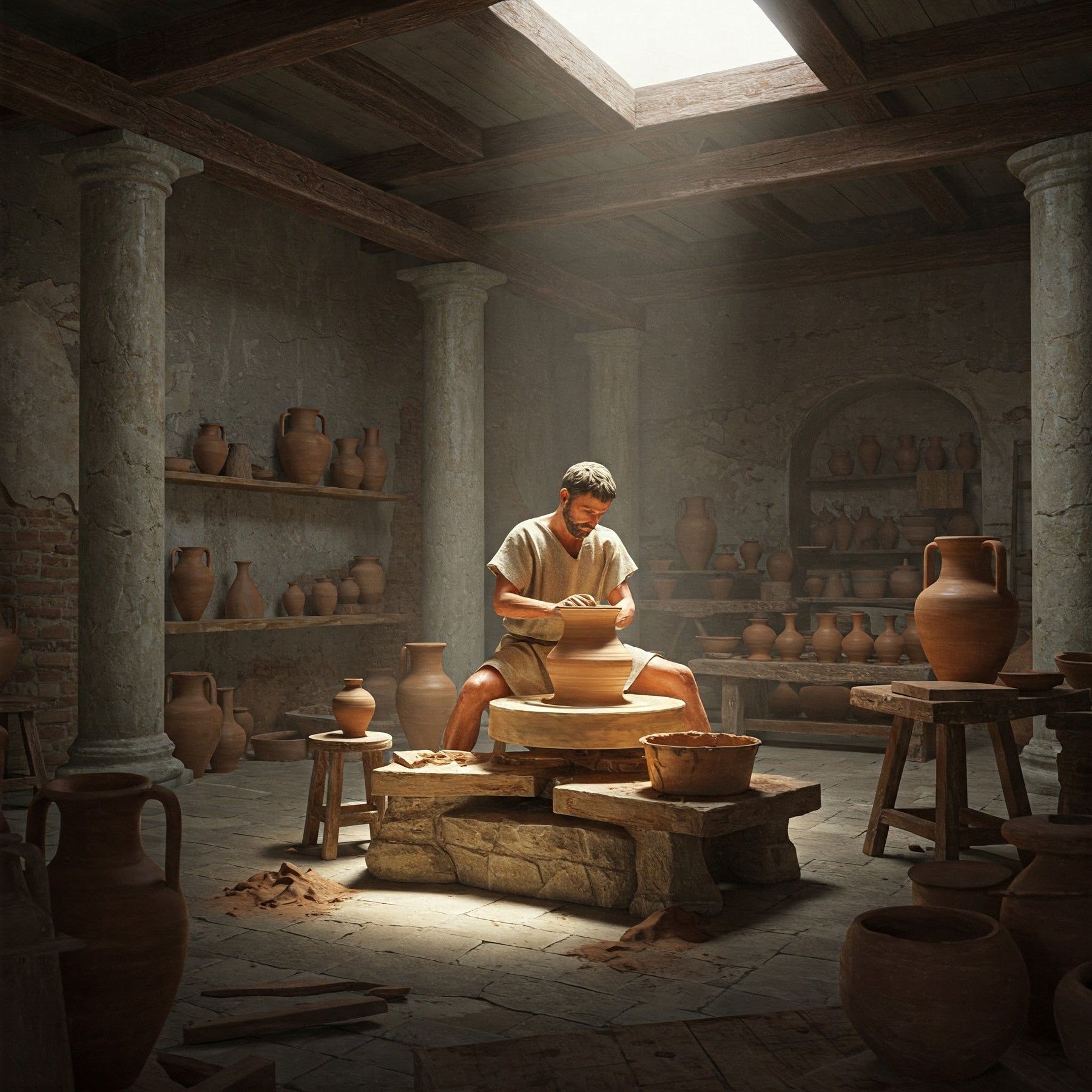
Where Was the Pottery Wheel Invented? A Journey Through History
Ever wondered who first decided to spin mud into masterpieces? Pottery Wheels were invented in ancient Mesopotamia, revolutionising ceramics around 4000 BCE. This game-changing tool turned wobbly hand-built pots into sleek, uniform vessels. History & invention collide in this fascinating journey—stick around to see how a simple wheel shaped civilisation!

The Dawn of the Potter’s Wheel: An Ancient Innovation
Defining the Potter’s Wheel: From Simple Turntables to Complex Machines
The first potter’s wheels weren’t the high-speed electric models we see today. Early versions were slow-turning wooden or stone discs, spun by hand to help shape pots more evenly.
Over time, the design evolved into kick wheels, where potters used their feet to keep the wheel spinning. This allowed them to shape larger, more intricate pieces with precision. Today’s electric models simply refine the same age-old concept—spinning clay to craft something beautiful.
The Significance of the Potter’s Wheel in Human History
Impact on Pottery Production and Craftsmanship
Before the wheel, making pots was a slow, manual process. Potters relied on techniques like:
-
Coiling – Rolling and stacking clay ropes to form a shape.
-
Pinching – Moulding small pots by pressing the clay with fingers.
-
Slab construction – Flattening sheets of clay and joining them together.
These methods worked but were time-consuming and inconsistent. The potter’s wheel changed everything—faster production, smoother shapes, and larger pieces became possible.
Role in the Development of Civilisations
Pottery wasn’t just about aesthetics. In ancient societies, it played a crucial role in food storage, cooking, and trade. The ability to create standardised, durable containers helped civilisations store surplus grain, transport liquids, and expand economies.
From Mesopotamian grain storage jars to Roman amphorae used for wine and olive oil, pottery shaped how people lived, ate, and traded.
Tracing the Origins: Mesopotamia and Beyond
The Sumerian Contribution: Early Evidence in Mesopotamia
Archaeological Findings in Ur and Surrounding Areas
Excavations in Ur, Eridu, and Nippur uncovered pottery shards with clear wheel-made markings. Clay tablets from the era even depict potters working at wheels, proving the wheel’s importance in daily life.
Dating the Earliest Potter’s Wheels
The first evidence of turntables for pottery dates to around 4500 BCE. By 4000 BCE, these evolved into fully functional wheels. The Sumerians had cracked the code—and pottery would never be the same again.
Other Potential Origins and Influences
Evidence in Ancient Egypt
Egyptians began using potter’s wheels around 3500 BCE, mainly for creating black-topped redware used in burials. Their wheels were initially hand-turned, but they greatly improved pottery efficiency.
Discoveries in Southeastern Europe
Finds from Bulgaria and Romania suggest that wheel-thrown pottery may have developed independently in Europe. Some pottery from 4500 BCE shows signs of being shaped using a rudimentary spinning method.
The Development of Pottery in Ancient China
China took things a step further. By 2000 BCE, they introduced foot-powered wheels, doubling efficiency. This innovation paved the way for the exquisite Tang dynasty porcelain centuries later.
The Evolution of the Potter’s Wheel Through Time
From Slow Wheels to Fast Wheels: Technological Advancements
The Introduction of the Flywheel
The breakthrough moment came with the flywheel—a heavy disc added below the wheel to keep it spinning longer. This meant less manual effort and smoother control for potters.
Foot-Powered and Mechanised Wheels
By 2000 BCE, potters in China and Greece introduced the kick wheel, where they could spin the wheel using foot power. This doubled production speed and allowed for more intricate designs.
The Spread of the Potter’s Wheel to Different Cultures
The Potter’s Wheel in Ancient Greece and Rome
Greek potters perfected the art of symmetrical amphorae for trade, while Romans took it further—mass-producing pottery for an empire. They even introduced turntables for making larger vessels.
The Potter’s Wheel in East Asia
Japan and Korea refined the potter’s wheel to create unique ceramic traditions, blending ancient techniques with their own artistic styles.
Pre-Columbian Pottery Techniques vs. Wheel Use
Interestingly, civilisations like the Aztecs and Mayans never widely adopted the wheel. Instead, they mastered hand-building techniques to create their stunning, intricate pottery.
Comparison of Ancient Pottery Wheels
The table below compares how different civilisations developed and used the potter’s wheel over time:
|
Civilisation |
Time Period |
Key Innovation |
|
Mesopotamia |
4500–4000 BCE |
First potter’s wheels |
|
Egypt |
3500 BCE |
Hand-turned wheels |
|
China |
2000 BCE |
Foot-powered wheels |
|
Greece/Rome |
700 BCE–500 CE |
Mass production, amphorae |
The Potter’s Wheel Today: Modern Applications and Legacy
Electric Potter’s Wheels and Contemporary Pottery
Today, potter’s wheels are motorised, precise, and highly efficient. Brands like Brent and Shimpo produce high-powered electric models used in studios worldwide.
The Enduring Importance of the Potter’s Wheel in Art and Craft
Despite technological advancements, pottery remains a hands-on art. Many artists prefer traditional wheels over electric ones, valuing the connection between hands and clay.
Preservation of Ancient Techniques
Historic pottery hubs, like Stoke-on-Trent, continue to honour ancient traditions, ensuring that hand-thrown ceramics remain alive.
Key Takeaways: Understanding the Historical Context
Summarising the Multiple Points of Origin
-
The pottery wheel was first developed in Mesopotamia, but variations appeared in Egypt, China, and Europe.
-
Innovations like the flywheel and foot-powered wheel transformed production speed and craftsmanship.
-
Not all cultures adopted the wheel—Pre-Columbian societies created exquisite pottery without it.
The Importance of Cross-Cultural Exchange
-
The potter’s wheel spread through trade, migration, and innovation.
-
Each civilisation adapted the wheel to suit their needs, shaping unique pottery traditions.
Even today, the humble potter’s wheel spins on, bridging ancient artistry with modern creativity. So, next time you hold a handmade mug, remember—you’re gripping a piece of history.

